Home Tags Posts tagged with "Astronomy"
Astronomy
Mountain-size asteroid 2004 BL86 will pass in the vicinity of Earth on January 26, 2015.
The space rock is roughly a third of a mile across.
By comparison, most near-Earth asteroids have diameters no larger than 50 to 100 ft.
But the asteroid is going by at a very safe distance of 745,000 miles. That’s about three times as far away as the Moon.
Asteroid 2004 BL86 is the largest known space rock predicted to come this close to Earth until 2027.Because it’s relatively large, 2004 BL86 will brighten rapidly as it approaches Earth.
Astronomers predict it will become about 9th magnitude for several hours as it passes closest to us. This is still much too faint to be seen by eye, and it is beyond the reach of most binoculars.
However, the asteroid should be bright enough to follow with a 3- or 4-inch-diameter telescope as it moves among the stars.
Observers in the Americas, Europe, and Africa can track down the asteroid during its brightest time: from 8 p.m. EST on Monday evening, January 26, until about 1 a.m. EST on January 27.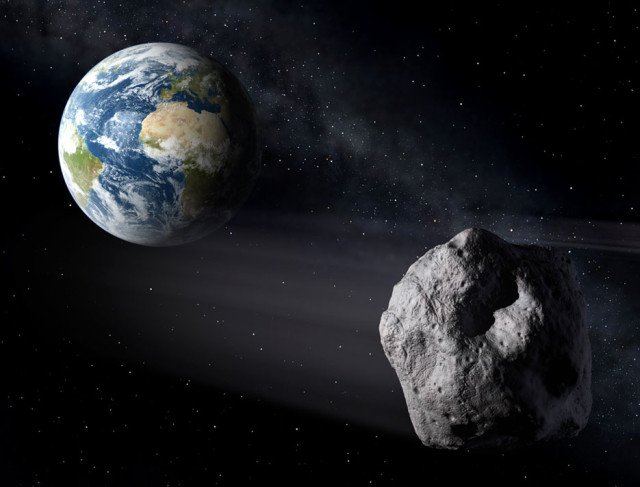
During this time 2004 BL86 will be heading northward through the dim constellation Cancer. It skims the eastern edge of a star cluster called the Beehive (or Messier 44) from about midnight to 12:30 a.m. EST.
The asteroid’s closest approach to Earth actually occurs hours earlier, around 11 a.m. EST on the 26th.
However, at that time it’s predicted to be somewhat dimmer, about magnitude 10, because Earth will see only a portion of its illuminated side.
The asteroid brightens, despite the increasing distance, because we’re seeing its face become more fully illuminated.
The space rock will be moving about 2.5° per hour while crossing Cancer. That’s fast enough that you’ll be able to see it moving in real time in a telescopic view whenever it passes close to a background star.
[youtube d5CYVIFUppQ 650]
Comet ISON was burned to death on its maiden voyage around the Sun, scientists say.
The comet, which excited astronomers and the media as it zipped within 730,000 miles of the sun on Thanksgiving Day, was pronounced dead at a scientific conference Tuesday.
Naval Research Lab astronomer Karl Battams, who headed the observing campaign for the comet, said ISON was stretched and pulled by the sun’s powerful gravity. It was also hit with solar radiation. And the icy snowball just fell apart.
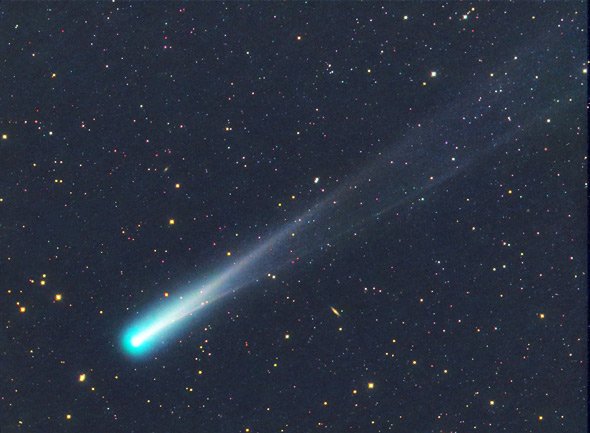
Comet ISON was burned to death on its maiden voyage around the Sun
“At this point it seems like there is nothing left,” Karl Battams said at the American Geophysical Union conference in San Francisco.
“Sorry, everyone, Comet ISON is dead. But its memory will live on.”
Astronomers had hoped it would survive because some comets make it past close approaches with the sun. Last year, Comet Lovejoy did.
According to some specialists, Comet ISON appears to have survived a close encounter with the Sun that had threatened to vaporize it.
The remnant could now go on to be visible from Earth in December, but astronomers do not know how bright it might become.
Travelling at more than 200 miles per second, ISON passed 730,000 miles above the sun’s 6,000C surface on Thursday evening. This would have heated the comet to almost 3,000°C, enough to vaporize rock as well as ice.
The hope was that the comet would remain sufficiently bright to be visible with the unaided eye throughout December. However, as ISON sped towards the sun, it faded dramatically from view. This led some experts to assume it had disintegrated.
“I’m not seeing anything that emerged from behind the solar disc. That could be the nail in the coffin,” said astrophysicist Karl Battams, from the Naval Research Laboratory in Washington, during a live broadcast on NASA TV.
Yet, rumors of the comet’s demise may have been greatly exaggerated. Overnight, something following ISON’s orbit re-emerged on the opposite side of the sun. Now it is brightening as it plunges back into deep space.
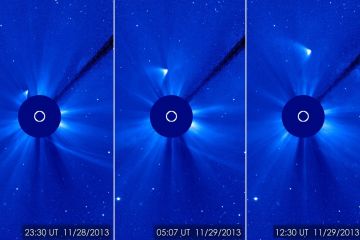
Comet ISON appears to have survived a close encounter with the Sun that had threatened to vaporize it
“To all intents and purposes it looked like it had gone, and then amazingly this thing appears out the other side,” said Professor Tim O’Brien, associate director of the University of Manchester’s Jodrell Bank observatory.
“What we don’t know is whether the whole thing fell apart and whether the dust that was embedded within the ice is just basically in a big cloud and that is continuing to orbit,” he explained.
“The question is, is it just a cloud of dust … or is there still either one or more remnants of the nucleus.”
The nucleus, a huge lump of rock and ice, was several miles wide on its approach to the sun, and brightened as the sun heated it to create an atmosphere, or coma, of ice and dust which was blown away from the sun to form a tail.
But radiation pressure, extreme heat and gravitational forces could have ripped the comet apart.
If the remnant is a cloud of dust it will rapidly dissipate. If it is solid the sunlight will continue to vaporize its ice, creating a tail that may be visible from Earth.
[youtube AtPvSwBWPRY 650]
Some part of Comet ISON may have survived its encounter with the Sun, scientists say.
The giant ball of ice and dust was initially declared dead when it failed to re-emerge from behind the star with the expected brightness.
All that could be seen was a dull smudge in space telescope images – its nucleus and tail assumed destroyed.
But recent pictures have indicated a brightening of what may be a small fragment of the comet.
Astronomers admit to being surprised and delighted, but now caution that anything could happen in the coming hours and days.
This remnant of ISON could continue to brighten, or it could simply fizzle out altogether.
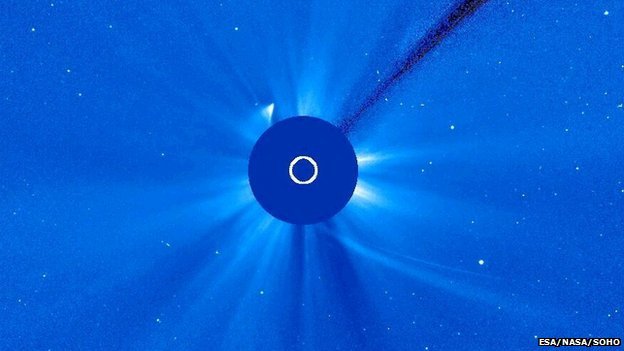
Some part of Comet ISON may have survived its encounter with the Sun
“We’ve been following this comet for a year now and all the way it has been surprising us and confusing us,” said astrophysicist Karl Battams, who operates the NASA-funded Sungrazing Comets Project.
The European Space Agency (ESA), too, which had been among the first organizations to call the death of ISON, has had to re-assess the situation. A small part of the nucleus may be intact, its experts say.
How much of the once 2 km-wide hunk of dirty ice could have survived is impossible to say.
Passing just 1.2 million km above the surface of the Sun would have severely disrupted ISON. Its ices would have vaporized rapidly in temperatures over 2,000C. And the immense gravity of the star would also have pulled and squeezed on the object as it tumbled end over end.
Karl Battams said: “We would like people to give us a couple of days, just to look at more images as they come from the spacecraft, and that will allow us to assess the brightness of the object that we’re seeing now, and how that brightness changes.
“That will give us an idea of maybe what the object is composed of and what it might do in the coming days and weeks.”
Whatever happens next, comets are going to be a big feature in the news over the next year.
[youtube h_mCNC31e9o 650]
Astronomers may have discovered one of the richest planetary systems yet.
The discovery of a seventh planet around the dwarf star KIC 11442793 could be a record, according to two separate teams of researchers.
The system bears some similarities to our own, but all seven planets orbit much closer to their host star, which lies some 2,500 light-years from Earth.
The crowded solar system is described in two papers published on the pre-print server Arxiv.org.
One of the identifications was made by volunteers using the Planet Hunters website. The site was set up to allow volunteers to sift through the public data from NASA’s Kepler space telescope – which was launched to search for so-called exoplanets – worlds orbiting distant stars.
Kepler uses the transit method to discover new planets, which entails looking for the dip in light as an alien world passes in front of its host star. But there is simply too much data for mission scientists to examine every light curve, so they developed computer programmes to search for the signature of a planetary transit.
“This is the first seven-planet system from Kepler, using a transiting search. We think [the identification] is very secure,” said Dr. Chris Lintott, from the University of Oxford, co-author on the Planet Hunters paper.
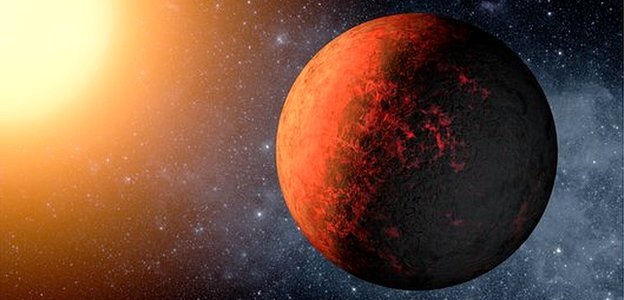
Astronomers may have discovered one of the richest planetary systems yet
“With a transiting system, once you get multiple planets, the odds of them being false positives are very small.”
Dr. Chris Lintott’s team has submitted their research to the Astronomical Journal for peer review. Another team of astronomers from several European countries has submitted a separate paper outlining their independent discovery of the seventh planet to the Astrophysical Journal.
The new planet is the fifth furthest from its parent star, orbiting with a period of nearly 125 days.
With a radius of 2.8 times that of the Earth, it fits into a family that now includes two roughly Earth sized worlds, three “super-Earths” and two larger bodies.
“It actually looks like our Solar System in one sense, with all the small planets on the inside and the big planets on the outside. And that’s not necessarily what we always see,” said co-author Robert Simpson, also from Oxford University.
While there might be resemblances to our Solar System, all seven planets are closer to their host star. In fact they would all fit within the Earth’s distance from the Sun, making this a very crowded neighborhood.
“This is one of the reasons they are easy to see, because the closer they are to their sun, the more frequently they go around it,” said Robert Simpson.
However, the Planet Hunters team carried out simulations showing that the planetary system should be a stable one.
Dr. Chris Lintott added: “Everything we know about this system tells us [the seventh planet] should have been found using the automatic detection routines. But it wasn’t.”
“A seven-planet system is very complicated so you get a sense of why the automatic routine might have missed out – it gets confused by the presence of the other transits.
“Looking for these transits seems like a task that’s perfectly designed for computers. But we keep finding, in these niche cases, in these odd cases, in these complicated cases that humans can beat the computers.”
Another star, HD 10180, has been claimed to have either seven, or nine planetary signals. A distant sun called GJ 887C may also have a family of seven planets.





